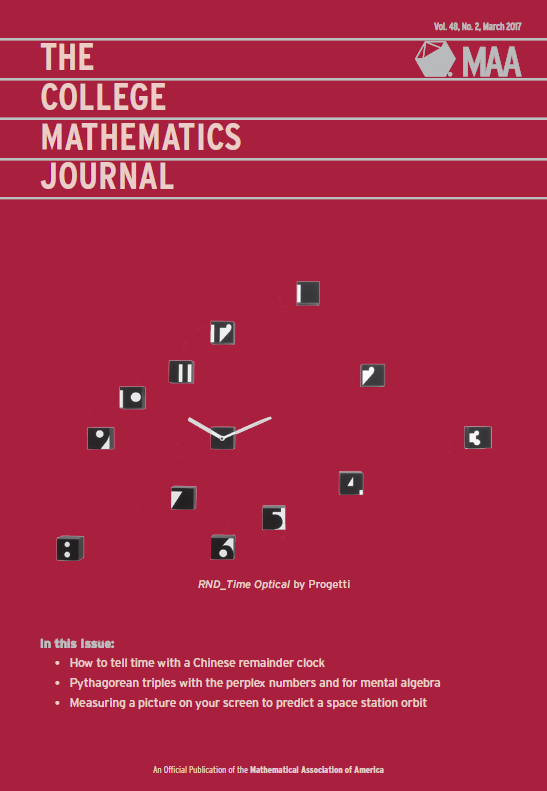- About MAA
- Membership
- MAA Publications
- Periodicals
- Blogs
- MAA Book Series
- MAA Press (an imprint of the AMS)
- MAA Notes
- MAA Reviews
- Mathematical Communication
- Information for Libraries
- Author Resources
- Advertise with MAA
- Meetings
- Competitions
- Programs
- Communities
- MAA Sections
- SIGMAA
- MAA Connect
- Students
- MAA Awards
- Awards Booklets
- Writing Awards
- Teaching Awards
- Service Awards
- Research Awards
- Lecture Awards
- Putnam Competition Individual and Team Winners
- D. E. Shaw Group AMC 8 Awards & Certificates
- Maryam Mirzakhani AMC 10 A Awards & Certificates
- Two Sigma AMC 10 B Awards & Certificates
- Jane Street AMC 12 A Awards & Certificates
- Akamai AMC 12 B Awards & Certificates
- High School Teachers
- News
You are here
College Mathematics Journal Contents—March 2017
Among the articles in this issue of The College Mathematics Journal are several that make extensive and essential use of graphics. The most dramatic is the alliterative "A Visual Validation of Viète's Verification" with several outputs from Sage's complex_plot command showing all roots of various polynomials. The Chinese remainder clock uses five circles to tell time with a favorite theorem of number theory and, amazingly, one can use a measurement from an image on the computer screen to make a good prediction of the International Space Station's orbit. In other articles, the perennially popular Pythagorean triples and Fibonacci numbers make appearances, along with a thoughtful consideration of the subtleties that arise when dealing with factorization. —Brian Hopkins
Vol. 48, No. 2, pp. 81-160
JOURNAL SUBSCRIBERS AND MAA MEMBERS:
To read the full articles, please log in to the member portal by clicking on 'Login' in the upper right corner. Once logged in, click on 'My Profile' in the upper right corner.
ARTICLES
The Chinese Remainder Clock
p. 82.
Antonella Perucca
We present an analog clock with five hands that illustrates the Chinese remainder theorem and that can be understood also by nonmathematicians. Moreover, we interpret the Chinese remainder theorem in terms of rotations and prove it without equations.
To purchase from JSTOR: http://www.jstor.org/stable/10.4169/college.math.j.48.2.82
A Visual Validation of Viète’s Verification
p. 90.
Tom Edgar and N. Chris Meyer
We visually investigate Viète’s method for funding for the roots of the depressed cubic equation using transformations and complex plots from Sage to consider the three cases
To purchase from JSTOR: http://www.jstor.org/stable/10.4169/college.math.j.48.2.90
Integral Values of the Generating Functions of Fibonacci and Lucas Numbers
p. 97.
Prapanpong Pongsriiam
Hong recently explored when the value of the generating function of the Fibonacci sequence is an integer. He noticed a pattern and raised some questions about it. Here, we completely answer those questions.
To purchase from JSTOR: http://www.jstor.org/stable/10.4169/college.math.j.48.2.97
Computing a Satellite Orbit From Photographs
p. 102.
Donald Teets
Simple measurements are taken directly from a photograph showing the track of the International Space Station over a 20-second interval. From these measurements, we are able to compute parameters for a circular approximation of the space station’s orbit and show that they compare favorably to NASA values for the same quantities.
To purchase from JSTOR: http://www.jstor.org/stable/10.4169/college.math.j.48.2.102
Forgotten Equations
p. 111.
Kazim Ali
To purchase from JSTOR: http://www.jstor.org/stable/10.4169/college.math.j.48.2.111
Pythagorean Triples for Easy Solutions of Certain Quadratics and a Newly Generated Tree
p. 112.
Edward R. Forringer
Certain quadratic equations can be solved by inspection if they share a pattern of differences with a Pythagorean triple. The connection between Pythagorean triples and quadratic equations also generates a tree of Pythagorean triples that has been discussed before but generated using matrices.
To purchase from JSTOR: http://www.jstor.org/stable/10.4169/college.math.j.48.2.112
Pythagorean Triples, Complex Numbers, and Perplex Numbers
p. 115.
Howard Sporn
After reviewing the use of Gaussian integers to generate Pythagorean triples, we consider the history of the perplex numbers and use them in an analogous way to generate Pythagorean triples. We also show that primitive Pythagorean triples form a group under the perplex number system, different from the group determined by the complex number representations.
To purchase from JSTOR: http://www.jstor.org/stable/10.4169/college.math.j.48.2.115
If a Prime Divides a Product…
p. 123.
Steven J. Miller and Cesar E. Silva
One of the greatest difficulties encountered by all in their first proof-intensive class is subtly assuming an unproven fact in a proof. The purpose of this note is to describe a specific instance where this can occur, namely in results related to unique factorization and the concept of the greatest common divisor.
To purchase from JSTOR: http://www.jstor.org/stable/10.4169/college.math.j.48.2.123
On the Arithmetic Mean of the Square Roots of the First n Positive Integers
p. 129.
Mircea Merca
In the paper, the author presents an asymptotic formula for the arithmetic mean of the square roots of the first n positive integers using only tools from undergraduate calculus.
To purchase from JSTOR: http://www.jstor.org/stable/10.4169/college.math.j.48.2.129
Classroom Capsules
Homographic Pencils for the Ellipse and the Hyperbola
p. 134.
Francisco Javier García Capitán
To purchase from JSTOR: http://www.jstor.org/stable/10.4169/college.math.j.48.2.134
A Very Short Proof that the Sum of Independent Normal Random Variables Is Normal
p. 137.
Bennett Eisenberg
To purchase from JSTOR: http://www.jstor.org/stable/10.4169/college.math.j.48.2.137
Problems and Solutions
p. 138.
To purchase from JSTOR: http://www.jstor.org/stable/10.4169/college.math.j.48.2.138
Book Reviews
Some Applications of Geometric Thinking and Moving Things Around By Bowen Kerins, Darryl Yong, Al Cuoco, Glenn Stevens, and Mary Pilgrim
p. 146.
Reviewed by: Thomas Dick
To purchase from JSTOR: http://www.jstor.org/stable/10.4169/college.math.j.48.2.146
Media Highlights
p. 153.
To purchase from JSTOR: http://www.jstor.org/stable/10.4169/college.math.j.48.2.153






